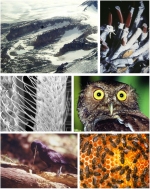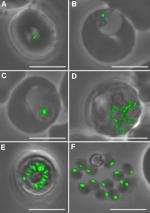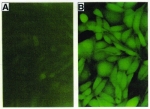Aim and Scope of the Book
“Nothing in biology makes sense except in the light of evolution”
Theodosius Dobzhansky
Evolutionary biology describes the history of life and why organisms are the way they are
 Our world has been shaped by an extraordinary diversity of living organisms. The Sun's light is harvested by bacteria, algae, and plants, while every feasible source of chemical energy, from hydrogen gas to carbon monoxide to phenol is exploited by some microbe (Figure 1). Life thrives in the most extreme environments, from Antarctic rocks to scalding undersea vents to crevices miles beneath the Earth's crust. Organisms are sensitive to the slightest variations in their environment: Bacteria find their way by sensing the Earth's magnetic fields, moths find their mates from a few molecules' scent, and owls see their prey from afar on a moonless night. Birds can use specialized tools to help them extract food, bees coordinate the activity of their hive, and human societies use language and technology to overcome the limitations of their biology. Our world has been shaped by an extraordinary diversity of living organisms. The Sun's light is harvested by bacteria, algae, and plants, while every feasible source of chemical energy, from hydrogen gas to carbon monoxide to phenol is exploited by some microbe (Figure 1). Life thrives in the most extreme environments, from Antarctic rocks to scalding undersea vents to crevices miles beneath the Earth's crust. Organisms are sensitive to the slightest variations in their environment: Bacteria find their way by sensing the Earth's magnetic fields, moths find their mates from a few molecules' scent, and owls see their prey from afar on a moonless night. Birds can use specialized tools to help them extract food, bees coordinate the activity of their hive, and human societies use language and technology to overcome the limitations of their biology.
All of these diverse functions are achieved by the same fundamental biochemical system. Genetic information stored in the sequence of bases in DNA is transcribed into RNA and then translated into sequences of amino acids that construct and maintain the organism. The engineering of organisms is as remarkable as its consequences. DNA sequences can be replicated with less than one error in a billion bases. Proteins at ambient temperatures can catalyze reactions that human chemists can achieve only under extreme conditions and with much coarser specificity. Interactions between DNA and proteins regulate precise patterns of gene expression that allow the reliable construction of complex organs—most impressively, the intricate connections in the brain that generate elaborate behavioral programs. All of this is determined by a remarkably compact genome; the human DNA sequence, for example, encodes less information than is stored in a personal computer.
We know, at least in outline, how the DNA sequence is translated into proteins, how these proteins effect metabolism and regulate gene expression, and how multicellular organisms develop reliably from a single cell. We also know, at least in outline, how the diverse organisms now living came to be. All of them (and us) descend from one “universal ancestor” that lived about 3.5 billion years ago. That ancestor itself descended from a much simpler organism in which RNA carried out the present roles of both DNA and protein. Thus, all the biochemical, morphological, and behavioral diversity around us descends from a few original genes.
The exquisite biological devices we now see appear as though carefully designed for their present purposes, and this appearance of design was long taken as evidence of an intelligent Creator. We now know that biological function is constructed and maintained by natural selection: the gradual accumulation of variations that arose by chance and that were preserved because they aided the reproduction of their carriers. The theory of evolution is a synthesis of Darwinian natural selection with Mendelian genetics. It allows us to ask not just how present-day life evolved, but also why it is as it is: Why do organisms develop from a single cell?; Why is the genetic code as it is?; and Why is there sexual reproduction?
Evolutionary biology is a valuable tool for scientists
The understanding of the history of life and the mechanism by which life has evolved has influenced virtually every aspect of human society from literature to medicine. However, evolutionary biology is not simply an historical science. Information on evolution and the application of principles learned from the study of evolution also have many practical uses in diverse fields such as geology, computer science, and epidemiology. We give here three examples.
 Because closely related organisms tend to have similar biological features, evolutionary classification can help predict the biology of an organism through comparison with its relatives. The great majority of microbes on this planet have yet to be cultured, which makes it difficult to study their physiology. Using molecular biology methods, genes from unculturable species can be cloned and evolutionary analysis of those genes provides the information to place the unculturable microbes into a tree of life. This permits closely related species to be identified, including ones whose biology has been studied. For example, this approach has led to the development of new drugs to treat malaria. Malaria is caused by the infectious eukaryotic parasite Plasmodium falciparum. Because humans are also eukaryotes, humans and P. falciparum share many aspects of their biology. Therefore drugs that have been developed to kill the parasite frequently are quite toxic to humans as well. In the 1970s, scientists studying an unusual substructure within the P. falciparum cell found that this organelle contained its own DNA. Much to their surprise, evolutionary trees of genes in this DNA indicated that this essential organelle, the apicoplast (a type of plastid) was actually closely related to chloroplasts of plants (Figure 2). This was significant, because plant chloroplasts originated from an endosymbiosis between plant ancestors and a bacterium related to modern-day cyanobacteria (Chapter 6). Evolutionary analysis has now shown that the Plasmodium lineage obtained this plastid by entering into a symbiosis with another eukaryote (most likely an alga) that contained a plastid. Although many of the features of this algalike symbiont have since been lost, the plastid was maintained. While the exact origins of the apicoplast in P. falciparum are still not known, the finding has revolutionized the search for chemotherapeutic agents to treat malarial infections. New drugs are being tested that target the apicoplast and that therefore have fewer side effects on humans. For example, the herbicide Roundup, which targets the chloroplasts of weedy plants, also kills P. falciparum. Relatives of P. falciparum cause many other diseases, and so chloroplast-targeted drugs may work against them too. Because closely related organisms tend to have similar biological features, evolutionary classification can help predict the biology of an organism through comparison with its relatives. The great majority of microbes on this planet have yet to be cultured, which makes it difficult to study their physiology. Using molecular biology methods, genes from unculturable species can be cloned and evolutionary analysis of those genes provides the information to place the unculturable microbes into a tree of life. This permits closely related species to be identified, including ones whose biology has been studied. For example, this approach has led to the development of new drugs to treat malaria. Malaria is caused by the infectious eukaryotic parasite Plasmodium falciparum. Because humans are also eukaryotes, humans and P. falciparum share many aspects of their biology. Therefore drugs that have been developed to kill the parasite frequently are quite toxic to humans as well. In the 1970s, scientists studying an unusual substructure within the P. falciparum cell found that this organelle contained its own DNA. Much to their surprise, evolutionary trees of genes in this DNA indicated that this essential organelle, the apicoplast (a type of plastid) was actually closely related to chloroplasts of plants (Figure 2). This was significant, because plant chloroplasts originated from an endosymbiosis between plant ancestors and a bacterium related to modern-day cyanobacteria (Chapter 6). Evolutionary analysis has now shown that the Plasmodium lineage obtained this plastid by entering into a symbiosis with another eukaryote (most likely an alga) that contained a plastid. Although many of the features of this algalike symbiont have since been lost, the plastid was maintained. While the exact origins of the apicoplast in P. falciparum are still not known, the finding has revolutionized the search for chemotherapeutic agents to treat malarial infections. New drugs are being tested that target the apicoplast and that therefore have fewer side effects on humans. For example, the herbicide Roundup, which targets the chloroplasts of weedy plants, also kills P. falciparum. Relatives of P. falciparum cause many other diseases, and so chloroplast-targeted drugs may work against them too.
 Evolutionary biology can also be very useful in understanding the relation between the structure and function of biological macromolecules. This is perhaps best shown through studies of ribosomal RNA (rRNA). In all living organisms rRNA is involved in the translation of messenger RNA into proteins. rRNA molecules form intricate structures in which they fold over onto themselves in part through internal base pairing, much like the base pairing in DNA that forms the DNA double helix (Figure 3). Biochemical analysis of rRNA molecules has been unsuccessful in determining what the likely folding patterns of these molecules are, in part because there are simply too many combinations to test. Until recently, structural studies have also been unsuccessful, because rRNA molecules do not readily form crystals, which are needed to solve structures by X-ray diffraction. However, the base pairings within the rRNA molecules were solved by tracing the evolutionary history of nucleotide changes and identifying cases in which changes occurred in two separate parts of the molecule at the same time. By identifying thousands of these correlated changes, researchers have been able to determine which positions formed base pairs with each other (Chapter 19). Evolutionary biology can also be very useful in understanding the relation between the structure and function of biological macromolecules. This is perhaps best shown through studies of ribosomal RNA (rRNA). In all living organisms rRNA is involved in the translation of messenger RNA into proteins. rRNA molecules form intricate structures in which they fold over onto themselves in part through internal base pairing, much like the base pairing in DNA that forms the DNA double helix (Figure 3). Biochemical analysis of rRNA molecules has been unsuccessful in determining what the likely folding patterns of these molecules are, in part because there are simply too many combinations to test. Until recently, structural studies have also been unsuccessful, because rRNA molecules do not readily form crystals, which are needed to solve structures by X-ray diffraction. However, the base pairings within the rRNA molecules were solved by tracing the evolutionary history of nucleotide changes and identifying cases in which changes occurred in two separate parts of the molecule at the same time. By identifying thousands of these correlated changes, researchers have been able to determine which positions formed base pairs with each other (Chapter 19).
 Numerous human endeavors have benefited from our understanding of how evolution works. For example, breeding programs, both of animals and plants, have been improved through the application of principles of population genetics. Similar approaches have even begun to be used in biotechnology, through the use of so-called molecular breeding (Chapter 17). A great deal of biotechnology research focuses on taking enzymes with known activities and increasing or changing these activities to achieve particular functions. One example is in the creation of new types of fluorescent proteins. These proteins are very useful tools in biological research, because their location within a cell can be readily visualized as a result of the light emitted by the proteins when placed under the proper conditions. To make the best use of fluorescent proteins, it is helpful to have different forms that emit different colored light. The only fluorescent protein isolated from nature is a green fluorescent protein isolated from a jellyfish species. Using in vitro molecular breeding methods, scientists have been able to create different versions of this original green fluorescent protein that fluoresce at alternative wavelengths. Standard approaches to this involved going through rounds of mutagenesis and then selecting for altered activity. Molecular breeding methods have used an understanding of the mechanisms of evolution to improve our ability to alter activity in the lab (Figure 4). For example, evolutionary studies have found that the evolution of new or altered activities can be limited by an inability to generate altered genes that carry combinations of several useful mutations. Recombination serves as a way of increasing the total number of mutations that can be produced by bringing together different single mutations and can greatly increase the efficiency of in vitro selection (Chapter 23). Numerous human endeavors have benefited from our understanding of how evolution works. For example, breeding programs, both of animals and plants, have been improved through the application of principles of population genetics. Similar approaches have even begun to be used in biotechnology, through the use of so-called molecular breeding (Chapter 17). A great deal of biotechnology research focuses on taking enzymes with known activities and increasing or changing these activities to achieve particular functions. One example is in the creation of new types of fluorescent proteins. These proteins are very useful tools in biological research, because their location within a cell can be readily visualized as a result of the light emitted by the proteins when placed under the proper conditions. To make the best use of fluorescent proteins, it is helpful to have different forms that emit different colored light. The only fluorescent protein isolated from nature is a green fluorescent protein isolated from a jellyfish species. Using in vitro molecular breeding methods, scientists have been able to create different versions of this original green fluorescent protein that fluoresce at alternative wavelengths. Standard approaches to this involved going through rounds of mutagenesis and then selecting for altered activity. Molecular breeding methods have used an understanding of the mechanisms of evolution to improve our ability to alter activity in the lab (Figure 4). For example, evolutionary studies have found that the evolution of new or altered activities can be limited by an inability to generate altered genes that carry combinations of several useful mutations. Recombination serves as a way of increasing the total number of mutations that can be produced by bringing together different single mutations and can greatly increase the efficiency of in vitro selection (Chapter 23).
Molecular biology and evolutionary biology are overlapping fields of study
Molecular biology and evolutionary biology are both thriving fields. Over the last half century, however, they have developed largely independently of each other. Of course, evolutionary biology uses many molecular techniques and investigates molecular as well as morphological and behavioral variation. Conversely, molecular biology uses (at least implicitly) evolutionary methods to establish relationships between organisms and between genes and to distinguish functional sequences. Nevertheless, the two fields remain as largely separate communities and ask rather different questions. Our aim in this book is to explain evolutionary biology in a way that will be accessible—and even interesting—to molecular biologists and to bring evolutionary methods to bear on at least some of the most recent molecular discoveries. We hope that as well as providing a clear explanation of biological evolution, our book will help to bring closer together these two strands of biology.
|

